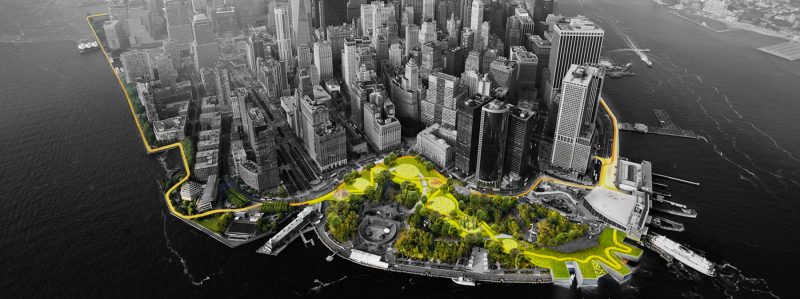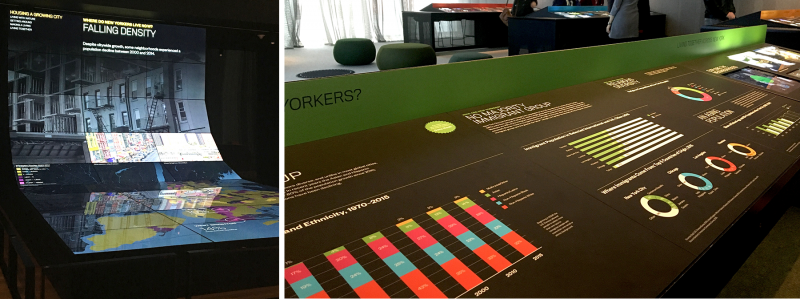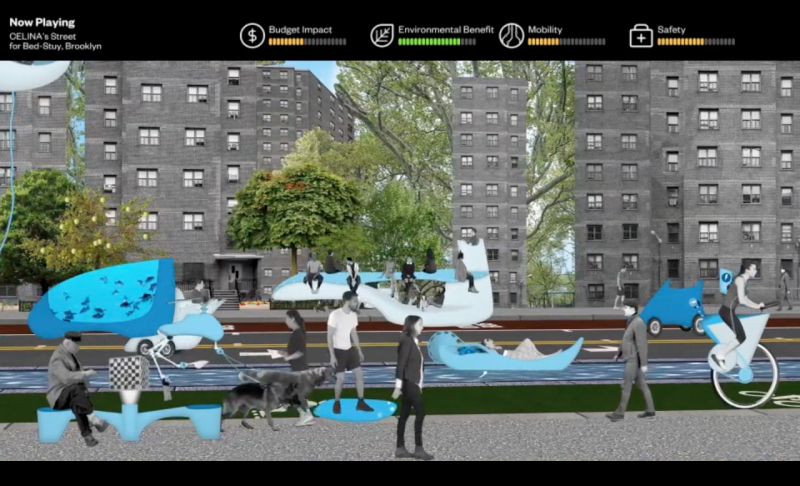Contributing to the future of New York City
Posted on December 5, 2016“Design can play a significant role in broadening our conception of what is possible”[1] by acting as a medium for discussion around sociocultural problems. This way of thinking about design can be disconcerting for some, as the practice is more commonly recognized from the problem-solving paradigm and linked to mass consumption. Although critical design first appeared many years ago, it has been, and still is, difficult to get people used to the idea that design can take a different path towards a more “cerebral rather than practical”[2] approach and it has been occasionally even confused with art. There is a reason for this misconception: as Dunne and Raby affirm, critical design adopts from art and literature different methodologies of shaping ideas as sources of inspiration.[3] The boundaries might be blurred, but there is certainly a marked difference between both of them, as critical design remains closer to our reality interrupting our conception of life as it is. What might be more confusing for some – as I believe – is that this design is presented to the world in spaces that are more commonly known to be occupied by art itself.
Museums and art galleries are usually interpreted as spaces where art in its different forms is preserved, stored and exhibited. They hold the memories of human culture, giving its audience the opportunity to learn and experience the past and present through the eyes of the artists. Art galleries are still considered places of knowledge rather than proposals and interrogations;[4] their established structure and techniques of display are conceived to expose, inform and educate, which might be not associated – by some – with the way design should be experienced.[5] In this disruption is where an interesting relation between the exhibitions and the spectators rests, as critical design pursuits to prompt reflection on the possible futures we might encounter and to spark debate around them by presenting futuristic alternatives that disturb the preconception of what we frequently witness in a museum. These spaces can build a new relation between society, culture and the imagination by offering an open space that bridges the speculative and the everyday life inviting the public to question the consequences of the technological, scientific and sociopolitical changes we are facing as a society.
During the last century, exhibitions in museums have change; they are not longer only about displaying the past, but they are gradually incorporating other type of experiences and what is more interesting, other timeframes. New York at its Core, a new permanent exhibition at The Museum of the City of New York, has opened a space centered around four themes: density, diversity, money and creativity, to explore the past but also to think about the future of the city.

Designed by Studio Joseph (exhibition design), Local Projects (experience design) and Pentagram (graphic design), the exhibition is ‘first-of-its-kind’[6]; Whitney Donhauser, Director of the museum expressed that it’s the first time “the entire exhilarating story of New York’s successive cycles of challenges and reinvention been told with more precision, passion, humanity, or excitement.”[7]
It starts with two galleries, Port City and World City, which achieve in a very dynamic way to show the events that have shaped the city in the past and recent years. Visitors walk throughout the history of New York starting in 1906 with the settlement of a small Dutch village to 2012 with the natural disaster of Hurricane Sandy.
Approaching the entrance of the last gallery of the exhibition, Future City Lab, the museum guide of the tour said, “Now, the final part is perhaps a surprise.” Once inside it felt very different from the previous spaces, there were not objects displayed in the walls, but instead workstations and an immense curved array of monitors with around 100 maps of New York City screening a compilation of data from housing to air pollution. Before concluding the tour the guide said, “I leave you here to speculate about the future of our city.”

The exhibition talks about the future of the society of New York and allows the spectator to participate in the alteration of imaginary scenarios, giving space to delve, reflect and discuss about the complex problems we are facing. It invites a diverse and wider public in the creation of the future, by giving them the possibility to participate in the decision-making process by creating solutions to the distinctive problems the exhibition rises.
“The imagination has become an organized field of social practices, a form of work, and a form of negotiation between sites of agency and globally defined fields of possibility […] the imagination is now central to all forms of agency, is itself a social fact, and is the key component of the new global order. ”[8]
There were multiple stations, all in which the visitors were invited to interact with, but the first that caught my attention was ‘What if.’ The explanation of the activity says: “These two small words open up a world of future possibilities unconstrained by today’s realities. They don’t just pose a question; they propose an idea about how things could be in the future.”[9] This space invites visitors to participate in a conversation about the future of the city, allowing them to write their own ‘what if’ questions but also to comment on others’ inquiries. It is about making people react to specific changes that could affect for better or worse their and everyone’s lives. Some questions around the table were: “What if we had one regional government for the greater New York City area? What if public transit stopped running late at night, as in most other cities?”

Following this first activity I moved to the active tables, where current statistics and data inform users about what challenges and opportunities the city and its citizens are expected to face in a near future. The desks are divided per issue: density, climate change, mobility, diversity and poverty, in which people are not only able to access detailed information but also to discover design strategies that have or are planned to solve similar problems around the world. But it doesn’t end there; visitors are invited to interact with these issues as urban planners, by imagining ways of tackling them. In a touchscreen, they are provided with a mix of futuristic objects to create their own ‘ideal scenario’. They are not only expected to choose what they find interested but the game encourages to think critically and to consider the effects of each decision, which are measured by several metrics like affordability, housing and biodiversity. These designs are then shared in a bigger screen with other museumgoers, and with motion sensors, people standing in front of it can become part of the scene, interacting in a playful way with the alternative futures visitors created.
The lineal interaction follows an order that I would like to define in four phases; awareness, motivation, active experimentation and a final moment of social interaction. New York at its Core is not only about exploring the past and present of the city, it has also turned the museum into a place of dialogue about the future. Jack Barton, the founder of Local Projects, explained, “The story we’re trying to tell, on the largest level, is the story of populist change, […] when people can organize themselves and channel it in a common direction, things get passed and things get built.”[11] To give visitors the possibility to design a preferable future and share it with the community is the most thought-provoking aspect of the Future City Lab; it leverages their knowledge and stimulates New Yorkers to feel involve with the future of their own city.
[1] Anthony Dunne and Fiona Raby, Speculative Design (United States of America, 2013), 162.
[2] Tim Parsons, January 2, 2014 (5:18 am), comment on John Thackara, “Republic of Salivation (Michael Burton and Michiko Nitta)”, Design and Violence, December 19, 2013, http://designandviolence.moma.org/republic-of-salivation-michael-burton-and-michiko-nitta/
[3] Anthony Dunne and Fiona Raby, Speculative Design (United States of America, 2013), 3.
[4] Liz Farrelly and Joanna Weddell, Design Objects and the Museum, 2016.
[5] Anthony Dunne and Fiona Raby, Speculative Design, 2013 (United States of America).
[6] [9] “Museum of the City of New York” www.mcny.org/story/future-city-lab
[7] Whitney Donhauser quoted in “The Museum of The City Of New York Announces permanen exhibition, NY AT IS CORE”, Broadway world, 2016, https://goo.gl/GzSZTw
[8] Arjun Appadurai, “Disjunture And Difference In The Global Cultural Economy” Theory, Culture & Society (1990) 31.
[11] Jack Barton quoted in Meg Miller in “How interactive design can help New Yorkers envision their city’s future” Fast Company 2016, goo.gl/dYVlaU
“Tony Dunne & Fiona Raby in dialog with Alex McDowell / 150 Years of the MAK”, Vimeo video, posted by MAK Wien, 2014. https://vimeo.com/97922387
Celina Lacaze
